If you're like CarPro Show host Jerry Reynolds, you're sad to the current Dodge Challenger and Charger models go as Dodge opens a new chapter in its muscle car history, one of electrification. So just what does that future look like? Dodge is giving us a good idea with the Dodge Charger Daytona SRT concept. The automaker calls it a glimpse at the brand’s electric future and says it won't just drive or look like a Dodge, but sound like a Dodge, too.
Dodge Charger Daytona SRT Concept
Dodge unveiled the two-door Charger Daytona SRT Concept last week during Dodge Speed Week in Pontiac, Michigan. It'll be powered by a new 800V Banshee propulsion system with performance that Dodge says exceeds its famed SRT Hellcat engine.
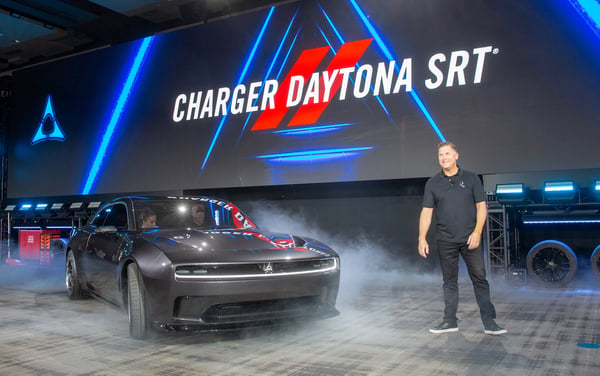
Tim Kuniskis, Dodge brand CEO – Stellantis, unveils the Dodge Charger Daytona SRT Concept. Credit: Dodge.
And yes, Dodge says it will still sound like a muscle car thanks to an industry-first BEV exhaust sound. You'll see subtle nods to Dodge's heritage in the car's design. Aerodynamics are key as well. Inside, a driver-center cabin awaits, as does a panoramic sunroof and fold-flat rear seats.
Three Core Concepts
Dodge says three game-changing, patent-pending, features are core to the concept:
- R-Wing: A unique aerodynamic pass-through design feature that connects the concept with its iconic Dodge Daytona namesake
- Fratzonic Chambered Exhaust: Industry-first BEV exhaust, can reach 126 dB, making it as loud as a Hellcat-powered Dodge
- eRupt: Multi-speed transmission with an electro-mechanical shifting experience that’s pure Dodge
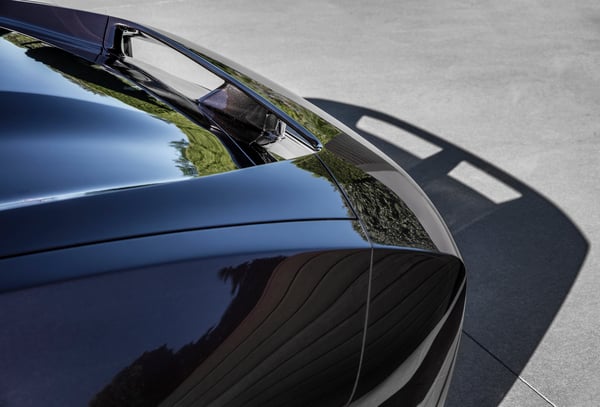 Dodge Charger Daytona SRT Concept’s R-Wing. Credit: Dodge.
Dodge Charger Daytona SRT Concept’s R-Wing. Credit: Dodge.
“The Dodge Charger Daytona SRT Concept exists because performance made us do it,” said Tim Kuniskis, Dodge brand chief executive officer – Stellantis. “Dodge is about muscle, attitude and performance, and the brand carries that chip on its shoulder and into the BEV segment through a concept loaded with patents, innovations, and pertformance features that embody the electrified muscle of tomorrow. The Charger Daytona SRT Concept can do more than run the car show circuit; it can run a blazing quarter-mile. And when it comes to product cycles, it outruns Darwin. Charger Daytona does more than define where Dodge is headed, it will redefine American muscle in the process."
Daytona History
Dodge chose the Daytona name for the concept on purpose. It's named after the famed Charger Daytona model that was the first vehicle to break 200 mph on a NASCAR track in 1970.
New Banshee Propulsion System
Dodge says the concept packs a performance punch as well - thanks to the new pinnacle of performance for the Brotherhood of Muscle -- Banshee. Dodge says the new propulsion system joins high-horsepower household names such as HEMI®, Hellcat and Redeye. Dodge says the 800V Banshee propulsion system makes the brand's first electric vehicle faster than a Hellcat in all key performance measures. The automaker says the standard all-wheel-drive system is key to besting the Hellcat's performance.
eRupt Transmission
Charger Daytona SRT Concept also introduces an eRupt multi-speed transmission with electro-mechanical shifting. Dodge says it delivers distinctive shift points, which will throw shoulders into seatbacks in true Dodge style. It's also equipped with a new PowerShot push-to-pass feature. Activated by the push of a button on the steering wheel, PowerShot delivers a jolt of increased horsepower for a quick burst of acceleration.
Fratzonic Chambered Exhaust
We mentioned this earlier - yes - the concept has an exhaust sound, the kind a muscle car fans expect. Dodge says the concept emits a 126 dB roar that equals the SRT Hellcat. It's generated through a new, patent-pending Fratzonic Chambered Exhaust system that sends sound through an amplifier and tuning chamber located at the rear of the vehicle.
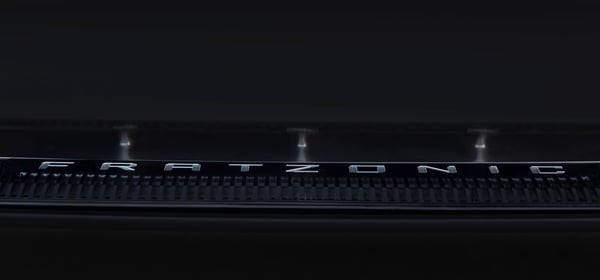 Credit: Dodge.
Credit: Dodge.
Design
The Dodge Charger Daytona SRT Concept - with its long and wide road presence blends the look of a modern BEV with subtle nods to its iconic past. It also has a new rear hatch design.
A new front end features a patent-pending aerodynamic R-Wing - a throwback to the original Charger Daytona design and to a key figure behind development of the original vehicle. It allows air to flow through the front opening, enhancing downforce. Dodge says the end result is an aerodynamically improved pass-through design. Carbon-fiber intakes tucked into both sides of the front and rear lower fascias provide an air curtain to assist in aerodynamic performance.
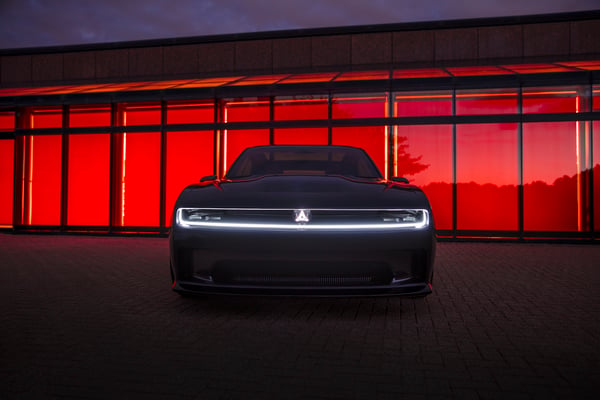 Credit: Dodge.
Credit: Dodge.
Dodge is also bringing back the Fratzog badge, originally featured on Dodge muscle cars from 1962 through 1976. It's now the new symbol of the brand's electrified future and you'll see the 3D badge on the front grille and tail lamp. Designers also aded vertical details on the front grille add as a homage to the iconic 1968 Dodge Charger.
The concept rides on 21-inch wheels with diamond-cut faces continue the aerodynamic efficiencies with a turbine-like design, and still another Fratzog logo embellishes the wheel center locks. Grey six-piston brakes provide the stopping power.
Connected, Driver-centric Interior
The modern cabin features a 12.3-inch center screen, the largest in a Dodge vehicle. It's angled nearly ten degrees towards the driver, and the 16-inch instrument cluster is curved, which Dodge says creates a cocooned, driver-focused feel. Lightweight, race-inspired seats have an insert that features a pattern of the Fratzog logo. Other features include a 8-by-3-inch Head-up Display (HUD), a slim, instrument panel and mid-bolster in Ultraviolet color with blue and silver accent stitching feature a “waterline” that extends cross car.
A parametric texture continues the inspiration of the 1968 Charger grille detail on the inside. The parametric pattern spanssrom the IP to door appliques, beneath the console and continuing to the rear armrests and rear console. Carbon fiber door sills feature illuminated white Daytona lettering, with lighted Daytona lettering also found at the top right of the mid-bezel.
The center console includes a unique jet-fighter-inspired cap that flips up when engaging the start button and a unique pistol-grip shifter design inspired by the past.
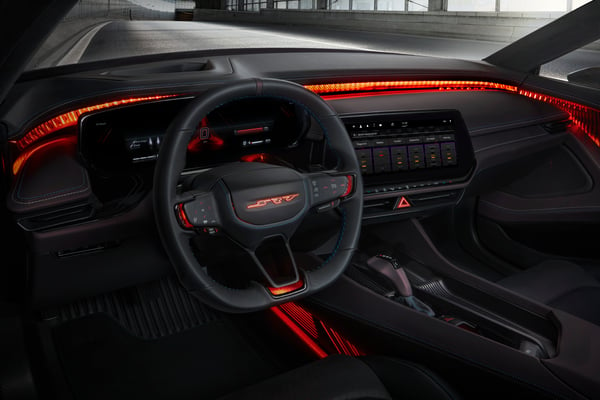 Credit: Dodge.
Credit: Dodge.
A new steering wheel design offers a thinner feel, with a flat top and bottom. The center spoke of the steering wheel is not connected to the rim, giving the steering wheel a floating feel. Paddle shifters are mounted on the steering wheel, with the PowerShot button on the right and drive mode controls on the left. Like the doors, the steering wheel features capacitive touch controls. An illuminated red SRT logo lights up the steering wheel center.
A simple one-button press on the steering wheel lets the driver pick from Auto, Sport, Track and Drag modes, instantly changing the driving dynamics, instrument cluster information, HUD content, performance sound and interior lighting features of the vehicle
Dodge says the carbon fiber “tub” floor and hatch are race-inspired lightweight features, and the large cargo area along with fold-flat rear seats provides more storage space than any previous Dodge muscle car.
Check out last week's reveal below:
.jpg?width=1020&name=dodge-caytone-srt-concept-feature-dodge-1404x1112%20(1).jpg)
